By Marco Vorobiev
Editor’s Note: This article is an excerpt from the Gun Digest Shooter’s Guide to AKs and first appeared online at GunDigest.com
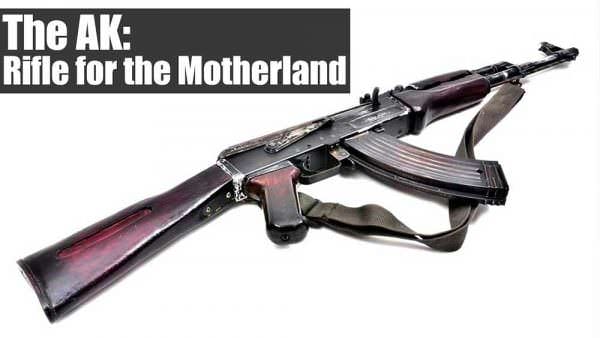
Gundigest.com
U.S.A. –-(Ammoland.com)- The history behind one of the world’s most storied rifles.
The appearance of the AK Rifle on the world stage was spurred not by the ambition of some government, but by the drive of one soldier to help his Motherland. It was in the hospital while recovering from wounds sustained in combat that Tank Corps Sergeant Mikhail Kalashnikov first had the idea to create an entirely new infantry rifle. After talking to many wounded infantry soldiers, the aspiring designer drew a picture of many shortcomings with Soviet small arms that were carried into combat against well-armed and equipped enemies.
He wanted to create a gun that would give his Motherland an advantage on the battlefield. Unlike many firearms designers, Kalashnikov was driven with only one desire: to make a contribution to his country’s victory over Nazi Germany.
He started work on his new gun in 1943 in Kazakhstan, where he was recovering from his wounds. It was there, and not in Tula or Izhevsk Arsenals, where the AK rifle got its roots. Later came years of trial-and-error, configurations and re-configurations, with relocation to the Degtyaryov Machine Plant in the city of Kovrov, before the very first AK sample was presented for testing in 1946.
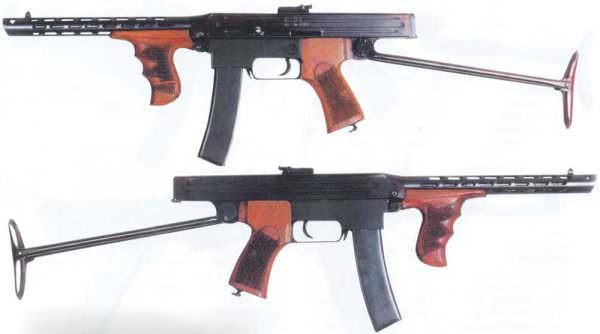
Meanwhile, the Germans were delivering a new rifle of their own to the battlefields of WWII, The MP 43 (Machinenpistole Model 1943), or later renamed by the Fuhrer himself, Stg .44 (Sturmgewehr Model 1944), the world’s first assault rifle.
The new rifle, created by Hugo Schmeisser, did not employ any new technological principals or concepts. After all, the concept of a battle rifle capable of full automatic fire and chambered for a less powerful cartridge compared to the conventional rifle caliber belonged to the Russian designer Vladimir Fyodorov and his automatic rifle.
Adapted for service with the Russian Imperial Army, the Avtomat Fyodorova (Fyodorov Automatic) chambered in the lighter 6.5x50mm Arisaka cartridge, was put into mass production in 1915 and saw service in WWI, the Bolshevik Revolution, the Russian Civil War and the Soviet “Winter” War against Finland.
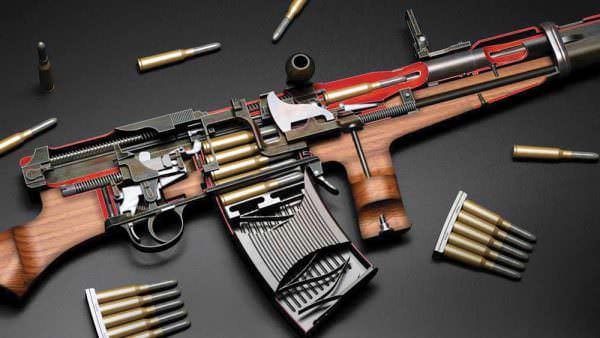
However, the true breakthrough for the new Stg .44 gun was the design and development of a new intermediate rifle cartridge, the 7.92x33mm Kurtz. This laid the basis for the development of virtually all modern carbine cartridges, including the infamous Soviet 7.62x39mm Model 1943, or as it is known, the M43 round. Another of Schmeisser’s achievements was the creation of a reliable rifle that could be built out of stamped steel and supplied to the troops quickly and in large numbers.
The decision to transition all the main small arms in the Soviet Union to an intermediate cartridge was made while WWII was still raging. Such a cartridge had been created by 1943, and shortly thereafter the development of the entire family of small arms began, including a self-loading carbine (SKS), the automatic assault rifle, and a light machine gun (RPD).
Several designers and designer teams entered the assault rifle development competition, and among them was young sergeant Mikhail Timofeyevich Kalashnikov, who at that time was already working on his new rifle.
In 1946 Kalashnikov and his team, alongside other participants, submitted a sample of his automat to the competitive evaluation, where it demonstrated very good results.
For the second stage of the competition that took place in 1947, Kalashnikov reworked his rifle, and in the modified form it was recommended for acceptance by the Armed Forces. After initial army tests in 1949, Kalashnikov’s automatic rifle was officially accepted as “7.62mm Kalashnikov’s Automatic Rifle model 1947,” or more simply, AK (sometimes in addition designated AK-47). In its original form the AK-47 had a combination receiver assembled from stamped and milled parts, however that design proved to be insufficiently rigid, so the AK-47 went into mass production with a fully milled receiver.
One of the myths connected with the AK is that Kalashnikov “copied” the AK from the German WWII assault rifle known as the Stg.44. At first glance, the external configuration of the AK and the Stg.44 is similar, as is the concept of the automatic weapon firing an intermediate cartridge. Similar barrel outlines, front sights and gas tubes are caused by the utilization of similar gas systems invented long before Schmeisser and Kalashnikov. Other than mere appearance, however, these rifles couldn’t be more different. It is quite probable that Mikhail Kalashnikov knew about the Stg.44, however it is also obvious that the creation of his rifle was guided by other known samples and systems.
Kalashnikov’s main achievement (or his team’s, to be exact) was optimum configuration of already known and proven solutions into one uniform working machine that met all the requirements.

Later, the original Kalashnikov design saw several changes. Due to production expense, the milled receiver was ditched in favor of a more economical and lighter stamped one. A muzzle brake compensator was added and the bayonet-knife was redesigned.
Everyman’s Rifle
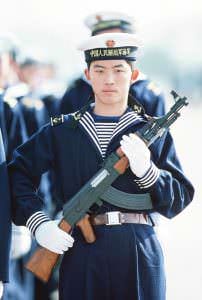
The inherent reliability, simplicity of production, and the simplicity of operation saw a huge demand for the new rifle. By the 1950s, the entire 1.5 million-strong Soviet Armed Forces were armed with AKs. After signing the Warsaw Pact that united militaries of all the socialist states in Europe, the need arose to standardize the way combined forces were armed and how they fought.
At the same time, scores of new AK rifles were already being supplied to communist China. Arming the Warsaw Pact allies put a strain on the Soviet firearm industry, so the decision was made to start licensing other countries to build their own AK rifles. This move would ultimately provide the necessary relief to increase domestic production and grow the import of AKs to the USSR “friendlies” around the world.
Proliferation of the AK throughout the world was done both ways: in the form of the ready weapon, and in the form of licenses to manufacture with all necessary documentation, tooling, and technical assistance.
AKs were manufactured in Bulgaria, Hungary, East Germany, Egypt, Iraq, China, Romania, North Korea, India, Finland, and Cuba. Even greater numbers were simply “given” to numerous other countries, basically anyone who would, even in passing, mention sympathy to the Marxist-Leninist ideology. The post-Soviet Union era saw the continuation of those licensing practices, with factories built in Venezuela, Libya, and Malaysia.

The spread of this iconic weapon is so wide that it is almost impossible to imagine an armed conflict today without an AK playing first fiddle in it. The rifle had seen service in every conflict in every theatre, from Korea to the present. Every so-called revolutionary group in South America, every anti-colonial movement in Africa in the 60s and 70s, every anti-west organization in the Middle East in the 80s, every Balkan conflict in the 90s, Iraq, Afghanistan, Al-Qaida, and ISIS, all are forever associated with AK rifles.
Many countries’ armed forces use the Kalashnikov rifle or one of its variants as their main battle rifle. In fact, more men and women in uniform carry AKs today than any other rifle, bar none. No other rifle even comes close.
Kalashnikov’s rifle has, to some extent, served as an example for design and development of such systems as Valmet (Finland), INSAS (India), Galil (Israel) and the SIG SG-550 (Switzerland). Commercial semi-automatic variants of the AK rifle enjoy considerable popularity in Russia and abroad, especially here in the US.
A truly prolific weapon, the AK in one form or another has been and continues to be sold by the millions. It is estimated that over 70 million rifles have been produced and sold worldwide.
AK Mastery
The AK-47 rose from the ashes of post-war Russia to become one of the modern era’s most reliable, potent and intriguing firearms. Gun Digest Shooter’s Guide to AKs arms enthusiasts and collectors with the knowledge to realize the full potential of these iconic rifles. The practical guide covers the major points of the many variants of the AK-47 and AK-74, detailing their development and impact on history. But author Marco Vorobiev does much more than tell the backstory of these incredible firearms. The former Soviet Spetsnaz (Special Forces) member also details the key areas modern shooters need to understand to buy, operate, maintain, train with and customize the Kalashnikov. Get yours now.
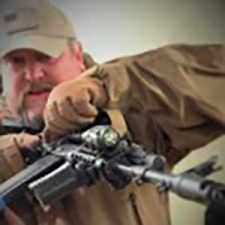
About Marco Vorobiev
A veteran of the elite Soviet Spetsnaz, now a U.S. citizen, Marco Vorobiev conducts firearms training classes using the methods he learned during his service. As a writer-consultant, Marco has handled and tested even the rarest AK variants. He is a prolific writer and contributor for firearms media, and has written hundreds of articles on AK history, training, practical application, modification and improvement. His articles have appeared in numerous firearms publications, including Guns & Ammo and Shotgun News.
